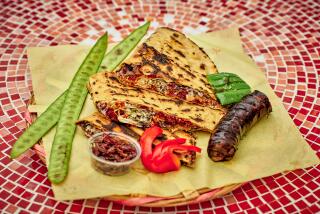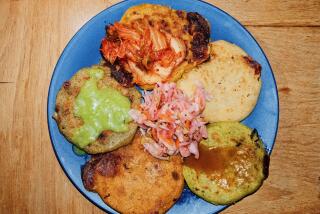Beyond Wholly Mole

Oaxaca is often called the “land of seven moles” because its residents are so fond of this elaborate dish. But I found much more to taste, from the weird (grasshopper pizza and salt mixed with powdered worms) to the aristocratic (a rose petal sorbet).
Last October I spent three weeks in the city of Oaxaca (Oaxaca is also the name of the state), so I had plenty of time to explore restaurants, bakeries and markets. I was here for Spanish immersion classes at the Becari Language School, which helped in discovering where to go, what to order and how the dishes were made. I came home with a guide to what I thought was the best food as well as a notebook full of recipes.
Oaxaca, a colonial city of 244,000 in the largely mountainous region of southern Mexico, is rich in indigenous culture, and it takes pride in a varied cuisine that preserves cooking techniques known long before the Spanish conquest.
Women sell bread baked at home in wood-fueled ovens. Corn tortillas, called blandas, are large, rustic and full of character. Some are made from black corn. Fragrant avocado leaves and an anise-scented herb, called hierba santa, perfume many dishes.
In market areas, women walk along with baskets of güías, tender shoots of the squash vine, on their heads. These are used in soup, along with squash flowers. Black beans are preferred, and quesadillas, made with squash flowers and the full-flavored string cheese known as quesillo, are outrageously good.
And then there’s mole. It’s probably sacrilegious to admit that I tried to avoid it, but I had overdosed on the dish, with its sweet, chocolate-infused sauce, while traveling in the state of Veracruz and in Puebla, home of mole poblano, Mexico’s national dish.
Eventually I succumbed, because it was unthinkable to leave Oaxaca without trying at least some of its moles. One taste and I realized that abstinence had been a big mistake, but more on that later.
Each day I worked out a dining agenda, from breakfast through coffee breaks, multi-course lunches and late evening snacks, taking buses to nearby towns to see what they offered.
A note of caution: It’s always a good idea to be careful eating abroad. I ate food from street stalls and almost anywhere without problems. But people’s constitutions differ. In recent years I have noticed that eating is safer and sanitary conditions are better than in the distant past. But any kind of change in food or water can cause problems. The old rules of thumb are still appropriate: Watch out for water (that means ice too), sticking instead with bottled drinks; eat only produce that is peeled; and try to avoid things grown on the ground.
With that in mind, here are some of the highlights from my eating adventures.
Breakfast
For delicious local specialties, go to the Mercado 20 de Noviembre, a big building filled with food stalls. It’s a couple of blocks from the zócalo, or square, just beyond the Mercado Benito Juárez, a large market where you can shop for dried chiles, local cheeses, fruits, flowers and handicrafts.
I usually ate at the Comedor Regional Chabela, a spotless place with a long menu. First came hot chocolate accompanied by a lightly sweetened anise-scented bun called pan de yema, then perhaps a bowl of fried cheese in tomato sauce flavored with chiles and epazote. If I wanted orange juice, a stall called Jugos y LicuadosWily would send over a tall glass of it, foamy and freshly squeezed.A leisurely breakfast at the outdoor restaurants along the zócalo is also nice. The pan de yema at La Primavera is especially good, softer and fluffier than some in the mercado; with a hot chocolate, you’ll pay about $2.25. Try huevos a la Oaxaqueña, an egg pancake folded around cheese and placed in a casserole of tomato sauce.
Lunch
The afternoon comida, a full-course set menu, starts so late that at 2:30 p.m., a restaurant might still be empty.
La Casa del Tío Güero on García Vigil, a small place that’s colorfully decorated with local artwork, charges about $3.50 for a comida that might include cream of spinach soup; huauzontle, a Mexican vegetable that looks like lacy broccoli, in a tomato or mole sauce; a fresh guava drink; and fried bananas smothered with cinnamon-flavored cream.
Casa Elpidia, a family-run restaurant, is hidden inside a walled building that surrounds a lush garden. Lunch, for about $4.50, starts with an appetizer plate that includes tastes of cheese, chicharrones (crisp pork skin) and an empanada stuffed with squash flowers.
Then you might have vegetable soup accompanied by warm bolillos, the Mexican version of the French roll, followed by a chile filled with sweet-tasting shredded pork; rice studded with corn kernels; flan and coffee. The perfect beverage is a tall glass of cold beer mixed with lime juice.
Dinner
It’s impossible to eat much after a hearty comida. For a light snack, go to Taquería El Primo on Calzada de la República to sample the gringas--small, thin flour tortillas folded taco style around carne al pastor (grilled marinated pork), onion, cilantro and a slice of fresh pineapple. They’re a little less than 80 cents each. El Primo’s atole de arroz, a hot, sweet rice drink, is soothing late at night.
Oaxaca is loaded with pizza, pasta and panini places that cater to tourists, but locals like them too.
Trattoria Pizza e Pasta L’italiano offers pizza Oaxaca, topped with cheese, grilled poblano and jalapeño chiles and, in the center, a scattering of crunchy, dark brown crumbs that turned out to be chapulines--tiny fried grasshoppers. Everywhere I went, vendors held out baskets of this delicacy. I could handle the insects on a pizza but not alone as a snack.
Less daunting is pizza Alu Eli, topped with tomato sauce, mozzarella and Oaxacan cheeses, green olives, mushrooms and squash flowers. Small pizzas run about $4.25.
The huge market called Central de Abastos smells like pesto because so many vendors stroll about with armloads of fresh basil. If that whets your appetite, go to La Rústica, a second-floor Italian restaurant that puts out a nice bowl of pesto with pasta imported from Italy.
Oaxaca has its own pizza, the clayuda. The base is an extra large, chewy corn tortilla, smeared lightly with asiento (fat from frying pork) and black bean puree, then topped with shreds of quesillo, the Oaxacan string cheese. Or it can be grilled meat such as cecina enchilada, which is thinly cut pork marinated with red chile. I had a clayuda with the pork. This plus a drink came to about $4.25.
Ice cream and icy drinks
Exquisite rose petal ice is a Oaxacan specialty. It’s made with small dried flowers, called rosas de Castilla (which you can buy from herb stalls in Mexican markets and even in L.A., on Olvera Street) rather than fresh rose petals.
One of the best versions is at Nieves Oaxaqueñas Chagüita in the Mercado Juárez. The astonishing menu lists 37 exotic ices, including leche quemada (burned milk), which tastes of smoke.
The plaza outside the Basílica de la Soledad on Independencia is filled with neverías, ice cream stands that offer as many flavors as Chagüita. Attendants set containers of sweet liquid in ice and spin them by hand until frozen.
A chain called Popeye is known for paletas (ice pops). Try a double, with pink cactus fruit ice on one end and leche quemada on the other.
Tall, cool drinks are the specialty of Aquí Casilda in the Juárez market. Casilda’s renowned drink is horchata made from ground almonds. It’s topped with cactus fruit marmalade, pecans and diced cantaloupe. When you stir in the red marmalade, the white drink turns bright pink. Casilda, by the way, uses only purified water.
Hot chocolate, coffee and mezcal
Hot chocolate is possibly Oaxaca’s favorite beverage. It’s served in a bowl, not a cup, and you’ll be asked to specify whether you want it made with agua (water) or leche (milk). The bowl allows easy dipping of the pan de yema that comes on the side.
Oaxacan chocolate is processed by grinding cacao beans with sugar and flavorings such as cinnamon and almonds. Two major processors, La Soledad and Mayordomo, have shops on F.J. Mina, just outside the Mercado 20 de Noviembre. You can sample before buying.
Oaxacan coffee is rich and strong. I bought freshly roasted beans from a cooperative that produces premium coffee in the highland area known as Pluma Hidalgo. Its export-quality coffee is Guishcaffie, a Zapotec Indian word that means “coffee mountains.”
Mezcal, Oaxaca’s smoky-tasting agave liquor, predates tequila. You can buy it plain or flavored with fruits, coffee, coconut or other additions, sweet or dry. One variation, labeled pechuga, was once distilled with a chicken breast. Now it’s more likely to be flavored with fruit. Liquor shops in the Mercado Juárez lure customers by offering samples. A traditional accompaniment is salt mixed with ground chile and agave worms. Vendors sometimes tuck in a packet with your purchase.
Mole
Oaxacan moles come in earthy colors such as brick red, yellow, green, brown and black. At its best, black mole--mole negro--is extraordinary, a complex blend of flavors with subtle smoke, berry and herbal overtones. Try it at El Biche Pobre on the Calzada de la República, one of the best places for traditional Oaxacan dishes. It’s also very good at the Comedor Familiar la Fonda, beside the market in the town of Etla, about 45 minutes by bus, and at La Capilla, a sprawling ranch-style restaurant near the town of Zaachila, about eight miles from here.
Green mole is colored with tomatillos, green chiles and fresh herbs. The sauce from mole coloradito, a red mole, is also used for enchiladas. The Comedor Anel, a market stall in Ocotlán, which is about 40 minutes from Oaxaca by bus, makes such good coloradito enchiladas that I went back for a second taste. There’s no filling, just cheese and onion rings scattered over the top.
From someone with no interest in mole, I’ve turned into such a fan that I’m returning to Oaxaca soon, not only to study Spanish but also to take a class in mole negro. A recipe in one Oaxacan cookbook calls for 28 ingredients, including four kinds of chiles, three kinds of nuts, red and green tomatoes, sesame and pumpkin seeds, chocolate, fragrant avocado leaves and a variety of spices and fresh herbs.
It’s going to be a challenge to gather the ingredients at home, but no effort is too great if it means I can taste this sublime dish whenever I please.
Barbara Hansen is a staff writer in The Times’ Food section.
More to Read
Sign up for The Wild
We’ll help you find the best places to hike, bike and run, as well as the perfect silent spots for meditation and yoga.
You may occasionally receive promotional content from the Los Angeles Times.






